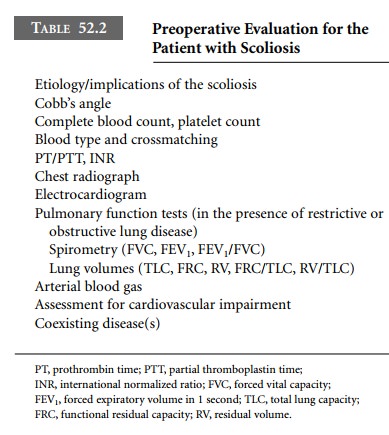Chapter: Clinical Cases in Anesthesia : The Jehovah’s Witness Patient
Describe the preoperative evaluation of the patient with scoliosis
Describe the preoperative evaluation of the patient with scoliosis.
A complete history and physical examination is
a necessary part of the preoperative evaluation. Primarily, the pre-operative
evaluation should focus on the cause and the implications of the scoliosis for
anesthetic management. The evaluation should include the degree of spinal
curva-ture, any cardiovascular impairment, and the presence of coexisting
disease(s). Table 52.2 lists the studies that may be performed as part of the
preoperative evaluation. Some or all of these studies will be ordered,
depending on the severity of the scoliosis.

Pulmonary function tests play a major role in
determining the anesthetic management of the patient for posterior spinal
fusion surgery. Restrictive lung disease is the most common pulmonary
abnormality observed with scoliosis. It is of particular note if the vital
capacity is 30% or less of predicted, as this will often indicate the probable
need for postoperative ventilation. If obstructive disease is present, it is
important to know its response to bronchodilators.
Cardiovascular impairment is not uncommon in
the patient with scoliosis. Mitral valve prolapse is the most common
cardiovascular abnormality seen in these patients. Pulmonary dysfunction may
cause changes in the pulmonary vasculature leading to pulmonary hypertension.
The end result of pulmonary hypertension on the cardiovascular system is the
development of right ventricular failure or cor pulmonale. Clinical findings of
cor pulmonale include an S4 heart sound, jugular venous distention,
hepatomegaly, pedal edema, and a left parasternal lift.
If a wake-up test is planned, then the
procedure and what is expected of the patient must be explained and
comprehended.
In the majority of patients, preoperative
sedation is acceptable. However, it should be kept in mind that some patients
with scoliosis will have a significant degree of respiratory dysfunction and
preoperative sedation may be contraindicated. The resulting respiratory depression
can cause hypoxemia, hypercarbia, and acidosis.
Related Topics